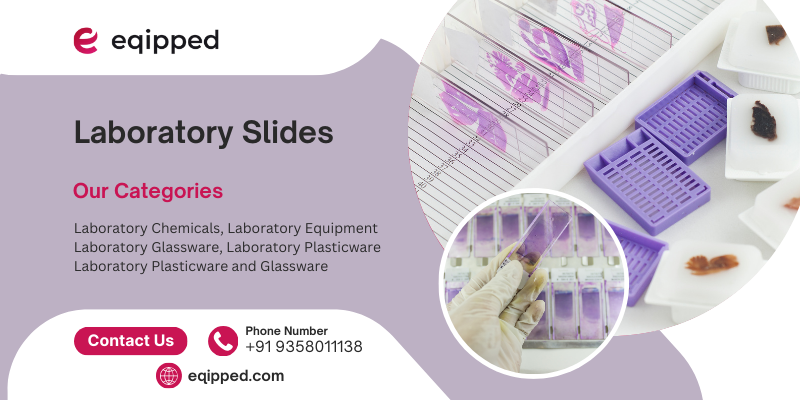Laboratory Slides: Innovations, Uses, and Emerging Trends in Modern Research

Laboratory slides are one of the most essential tools in scientific research, diagnostics, and education. Though they may appear simple—just a thin piece of glass or plastic—their role in biology, pathology, chemistry, and material sciences is indispensable. With advancing technology and research demands, laboratory slides have evolved from being basic observation platforms to highly specialized tools that support precision, automation, and digital transformation in laboratories worldwide.
In this blog, we will explore what laboratory slides are, their importance, the latest trends shaping their use, and how they are revolutionizing scientific practices in the modern era.
What Are Laboratory Slides?
A laboratory slide is a thin, flat piece of glass or plastic, typically rectangular in shape, used to hold samples for microscopic examination. Slides are paired with cover slips (thin sheets placed over the specimen) to protect the sample and improve image quality under a microscope. They are used extensively in biological, medical, and chemical laboratories for:
Examining tissues and cells in pathology and histology.
Viewing microorganisms like bacteria, fungi, and protozoa.
Analyzing chemical reactions at the micro-level.
Educational purposes in schools and universities for teaching biology and related sciences.
Their simplicity makes them universal, but new advancements are making laboratory slides smarter and more efficient.
Types of Laboratory Slides
While the traditional plain glass slide is still widely used, modern research requires specialized slides for unique applications:
Plain Slides – Standard transparent glass slides used for general purposes.
Frosted-End Slides – Provide labeling space for easy sample identification.
Adhesive-Coated Slides – Useful for tissue sections, ensuring samples stick firmly without damage.
Charged Slides – Positively charged slides that help bind negatively charged biological tissues and cells.
Concave Slides – Feature depressions to hold liquids or large specimens.
Fluorescent Slides – Coated for fluorescence microscopy in molecular biology and genetics.
Digital/Smart Slides – Emerging slides designed for scanning and integration with digital imaging systems.
Why Laboratory Slides Are Essential
The laboratory slide plays a central role in connecting observation to discovery. Its importance can be highlighted across various domains:
Medical Diagnostics: Pathologists rely on stained tissue slides to identify diseases, including cancer.
Research: Microscopic slides help researchers observe cellular structures, molecular interactions, and chemical reactions.
Education: They enable practical learning for students studying biology, zoology, and microbiology.
Pharmaceutical Development: Used in drug testing and analysis of biological responses at the cellular level.
Without laboratory slides, advancements in healthcare, medicine, and biology would be nearly impossible.
Trending Topics in Laboratory Slides
As technology evolves, laboratory slides are undergoing innovation. Let’s explore the trending topics transforming their role:
1. Digital Pathology and Virtual Slides
One of the biggest trends is the digitization of laboratory slides. With high-resolution scanning, slides can now be converted into virtual slides that can be shared, analyzed, and stored digitally. This is especially beneficial for:
Remote diagnostics and telepathology.
AI-powered analysis of tissue and cell structures.
Archiving large datasets without the need for physical storage.
This trend is shaping a new era of precision and efficiency in pathology and medical education.
2. Nano-Coated Laboratory Slides
Modern slides are being developed with nano-coatings that enhance sample adhesion, reduce contamination, and improve fluorescence imaging. These coatings make them ideal for molecular biology and genetic research, where precision is critical.
3. Automation in Slide Preparation
Automated slide preparation systems are trending in laboratories worldwide. These machines handle staining, labeling, and mounting, ensuring standardization and saving time in high-volume labs. This automation also reduces human error, improving diagnostic accuracy.
4. AI and Machine Learning Integration
With the rise of AI, laboratory slides are no longer just observation tools. When scanned and digitized, they become datasets that can be analyzed with machine learning. AI algorithms can detect abnormalities in tissue samples faster than traditional manual methods, assisting pathologists in making quicker, more accurate decisions.
5. Eco-Friendly Laboratory Slides
Sustainability is now a global priority. Manufacturers are innovating biodegradable and reusable laboratory slides to reduce waste. Eco-friendly production methods, recyclable materials, and reusable options are gaining popularity in both research and education sectors.
6. Customized Laboratory Slides for Research
Researchers now demand laboratory slides tailored to their experiments—whether it’s slides pre-coated with antibodies, grids for nanotechnology, or slides designed for DNA hybridization. Customization is becoming a key trend, offering scientists greater flexibility.
Laboratory Slides in Education
Beyond advanced research, laboratory slides remain essential in education. Schools and universities increasingly use prepared slide kits to teach topics like cell biology, plant anatomy, and microbiology. The integration of digital slides into virtual classrooms has also enhanced online learning experiences, making science education more accessible.
Future of Laboratory Slides
The future of laboratory slides lies at the intersection of technology and sustainability. We can expect to see:
Smart slides embedded with microchips for automated sample identification.
Cloud-based slide databases for global collaboration in research.
AI-driven analysis platforms that minimize human workload in diagnostics.
Green laboratory slides made from sustainable materials to align with eco-conscious practices.
These trends ensure that even a simple laboratory slide continues to evolve as a powerful enabler of scientific progress.
Conclusion
The laboratory slide, once considered a basic accessory in laboratories, is now at the center of innovation. From digital transformation and AI integration to eco-friendly designs, slides are adapting to the needs of modern science. Their role extends far beyond observation—they enable discovery, diagnosis, and education.
As researchers, educators, and medical professionals continue to push boundaries, the humble laboratory slide will remain a vital part of scientific exploration, bridging tradition and technology in remarkable ways.






